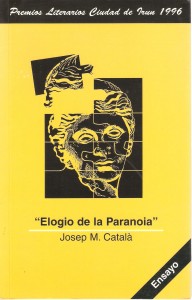This essay proceeds to sever the concept of paranoia from the strictly psychopathological field, in order to place it within the sociocultural panorama of postmodernity with the intention of explaining, in a way that transcends the simple metaphor, the intimate structure, not only of our reality but also of our conditions of users of that reality. Turning to a far-reaching interpretation of the paranoid state, along with the consequent overcoming of the idea of sign by that of symptom, leads us, if not to a complete, and because of this impossible, comprehension of the complexity that characterizes contemporary phenomena, at least to the possibility of glimpsing its vast applications. In our societies, simultaneously to the dramatic increase of the amount of information that assaults us from multiple angles –without us being able to control either its sources or its strict utility– we are given tools which lead us to believe that we can dominate and manage such an avalanche.
And even if it is true that we are able to command great networks of data that extend throughout the whole universe, of establishing connections that are so unsuspected that they end up making us be suspect of everything, it is also true that, at the same time that we are immersed in this frenetic activity, we find ourselves captivated by it: we are possessed by the grisly euphoria of one who rides on the back of the tiger.
This essay aims to expose the nature of these changes, by focusing –in a special, though not exclusive, way– on the field of the contemporary image, not only because it is here that the most important transformations are forged, but also because there is nothing so related to paranoia as hallucinatory processes, and our new digital technologies come full of promises in this sense.
CONTENT
INTRODUCCIÓN: UNA CIENCIA DE LOS SÍNTOMAS
Lacan y los doctores del templo
¿Sueñan los androides con ovejas eléctricas?
Un paseo por el bosque de las metáforas
El signo como síntoma
La insoportable retórica de lo simple
La terapéutica y su enfermedad
Entre la señorita Dorothy y el caballero Daupin
Ver para creer
Un catálogo de síntomas
Los usos de mal
Instrucciones de uso
I. ROSA APOCALÍPTICA
La enfermedad considerada como una de las bellas artes
La hipocondría como germen de la paranoia
De lo visible y lo invisible
El paranoico y su propiedad
El género del paranoico
Las propiedades del paranoico
El triunfo de la geometría
El elogio de la locura
La historia de la historia
La modernidad como pasatiempo
La pérdida que no cesa
II. LA VISIBILIDAD DEL DOLOR
La cárcel de la metáfora
El mal del siglo
El fantasma del dandismo
El espacio del consumidor
El modernismo como enfermedad
La sensación como fragmento
La importancia de las redes
La realidad como pintura
Paranoia en familia
El halcón y la flecha
La clandestina profesionalidad del asesino
La suciedad de la información
El amo del universo
El dulce narcisismo del impostor
Maquinaciones cuánticas
Redes de eternidad
Viajes alucinantes
Perdidos en la metáfora
A la sombra de los objetos en flor
Conversación con Liliput
La realidad, entre lo cuantitativo y lo cuántico
La mala conciencia del superhéroe
El paranoico como escisión de la realidad
El robo del cuerpo del rey
Viaje a las profundidades de lo real
III. ALUCINACIONES
Entre la tela y la araña
Prolegómenos del delirio
Antiguos contra modernos
Hacia una imagen líquida
De la mecánica a la hidráulica
Una desolación muy familiar
El porvenir de una ilusión
La radio, ventana al mundo
En las fronteras del lenguaje
Esplendor entre ruinas
La página como escena
La triple articulación
La lógica del delirio
Patología del lenguaje
La nueva ingenieria social
Neurosis y conocimiento
El pensamiento-red
La poética de la información
La mente no funciona de esta manera
El ojo ragado
La mente del memorista
Conocimiento e interpretación
El negocio de la podredumbre
IV. REFLEJOS DE LA OTRA PARTE
Del vacío a la fragmentación
Del fragmento al movimiento continuo
La multiplicación de la mirada
El universo en llamas
Manicomios urbanos
La vida de las abejas
La conciencia de nuestro tiempo
El encanto de lo incompleto
V. EL ESPACIO PARANOICO
Ecce Homo
La fluidez del nuevo espacio
Un universo de formas fluidas
El texto desencadenado
Puesta en escena de la alucinación
En el país de los gestos
La forma del espacio
La proyección y el cuerpo
EPÍLOGO: EL IMPRERIO DE LOS SÍNTOMAS

